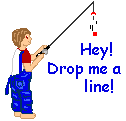- Your Government
-
Our Community
-
- About St. Helens History of St. HelensState of the CityCourthouse Dock Camera
- Local Events City Calendar Citizens Day in the ParkRecreation Activities Discover Columbia County Sand Island CampingKeep It Local CC
- Community Resources City Newsletter City Social Media Emergency Services New Resident InformationProtecting Our Environment
-
-
Business & Development
-
- Local Business Directory Get a Business License City Bids & RFPs Broadband Study
- Business in St. Helens St. Helens Advantages Directions & Transportation Incentives & Financing Resources for Businesses Business Guide Columbia Economic Team Chamber of Commerce
- Current City Projects Waterfront Redevelopment Public Safety Facility Strategic Work Plan
-
-
How Do I?
-
- Apply for a Job Apply for a Committee Find A Park Find COVID Info Find Forms Follow St. Helens - Facebook Follow St. Helens - Twitter Follow St. Helens - YouTube
- Get a Police Report Get a Business License Get a Library Card Get a Building Permit Newsletter Signup Past Public Meetings Pay My Water Bill
- Public Records Request Report a Nuisance Register for Rec Activity Reserve a Park Sign Up for the 911 Alerts Universal Fee Schedule
-
Cryptosporidium: A Waterborne Pathogen
B.K. Avery, A. Lemley and A.G. Hornsby
What is Cryptosporidium?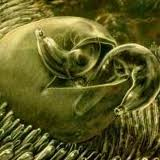
Cryptosporidium (crip-toe-spor-ID-ee-um) is a protozoan, a single-celled, microscopic pathogenic (disease causing) parasite that lives in the intestines of animals and people. The parasite can cause a gastrointestinal illness called cryptosporidiosis (crip-toe-spor-id-ee-0-sis). The dormant (inactive) form of Cryptosporidium , called an oocyst (0-o-sist), is excreted in the feces (stool) of infected humans and animals. The tough-walled oocysts survive under a wide range of environmental conditions.
What are the symptoms of cryptosporidiosis?
The most common symptom of the disease is watery diarrhea. There may also be abdominal cramps, nausea, low-grade fever, dehydration, and weight loss. Symptoms usually develop 4 to 6 days after infection, but may appear any time from 2 to 10 davs after infection.
People with healthy immune systems are usually ill with cryptosporidiosis for several days but rarely more than two weeks. Some infected individuals may not even get sick. Some people with cryptosporidiosis seem to recover, then get worse again. Those who are infected may shed oocysts in their stools for months, even after they no longer appear to be ill.
Cryptosporidiosis may cause complications for those with illnesses or conditions such as diabetes, alcoholism, or pregnancy. The effects of prolonged diarrhea and dehydration can be dangerous, especially for the very young, the elderly, and the frail.
Cryptosporidiosis is most severe and long-lasting in immuno-compromised individuals (those whose immune systems are weak), such as people infected with HIV (the virus that causes AIDS), cancer patients on chemotherapy, transplant patients, or others taking medications that suppress the immune system. This disease can be life-threatening for the immuno-compromised.
How is this disease diagnosed and treated?
Cryptosporidiosis cannot be diagnosed by symptoms alone. Watery diarrhea is a symptom of many intestinal diseases caused by bacteria, viruses, or parasites. If Cryptosporidium is the suspected cause of an intestinal illness, the doctor should request a specific diagnostic test.
There is currently no drug that can cure cryptosporidiosis. People with competent immune systems will recover on their own and appear to develop some immunity to subsequent infections. Anti-diarrheal medicines may ease some of the symptoms. Anyone with diarrhea should drink plenty of fluids to prevent dehydration.
How is the pathogen spread?
You can get infected with Cryptosporidium when you put anything in your mouth that has been in contact with feces from an infected animal or person. When large numbers of people get cryptosporidiosis, the source of infection can sometimes be tracked down, but it is impossible to determine the origin of many individual cases of this disease.
Your hands may be contaminated with Cryptosporidium through person-to-person contact, perhaps while changing a child’s diaper, caring for someone with diarrhea, or engaging in any activity that involves touching areas of the body contaminated with feces. Cryptosporidiosis can be easily spread among people in close social groups such as families, day care centers, and nursing homes. People who work with animals, especially young animals or animals with diarrhea, have a greater chance of exposure to the parasite. You may pick up oocysts while handling a litter box, soil, or any object contaminated with even a small amount of feces.You can also get cryptosporidiosis by drinking water or eating food that has been contaminated with oocysts. Drinking untreated surface water (such as streams, rivers, and lakes) or swallowing a small amount of water when swimming, even in a chlorinated pool, can cause cryptosporidiosis. The parasite may also be spread in uncooked foods, beverages, or ice prepared with contaminated water. Unwashed fresh fruits or vegetables may carry oocysts if manure was used or animals grazed where the crop was grown.
People who are infected (or whose hands become contaminated) with Cryptosporidium can spread the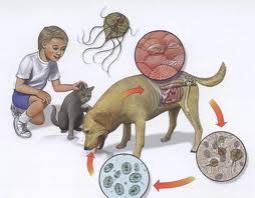 disease to other people or pets if they are not careful about their hygiene. Frequent hand washing is the single most important thing people can do to avoid spreading cryptosporidiosis and other illnesses. It is especially important to wash thoroughly before preparing food as well as after using the toilet.
disease to other people or pets if they are not careful about their hygiene. Frequent hand washing is the single most important thing people can do to avoid spreading cryptosporidiosis and other illnesses. It is especially important to wash thoroughly before preparing food as well as after using the toilet.
Oocysts are not killed by typical household disinfectants, including bleach, but are killed at temperatures over 160 degrees Fahrenheit (hotter than most domestic hot tap water). Thorough drying in a clothes dryer will kill oocytes by desiccating them.
Is cryptosporidiosis a new disease?
Cryptosporidiosis has long been a veterinary problem, predominantly in young farm animals such as calves.Cryptosporidium , was first recognized as a cause of human disease in 1976 but was rarely reported in humans until 1982. The number of detected cases began to rise rapidly along with the AIDS epidemic and the development of methods to identify the parasite in stool samples. The earliest cases of human cryptosporidiosis were diagnosed in animal handlers. An outbreak at a day care center was first documented in 1983.
In 1987, 13,000 people in Carrollton, Georgia, became ill with cryptosporidiosis. This was the first report of its spread through a municipal water system that met all state and federal drinking water standards. In the spring of 1993 in Milwaukee, Wisconsin, municipal drinking water, again within standards, was found to be contaminated with Cryptosporidium . An estimated 400,000 people became ill, and the disease contributed to the deaths of some AIDS patients. These outbreaks focused attention on the risk of waterborne cryptosporidiosis and the possible need for stricter drinking water standards.
How many people get cryptosporidiosis?
We do not know exactly how many cases of cryptosporidiosis actually occur. Many people do not seek medical attention or are not tested for this parasite, and so Cryptosporidium often goes undetected as the cause of an intestinal illness.
Health professionals in some states are on the lookout for cases of cryptosporidiosis through surveillance programs at hospitals, clinics, and labs. The Centers for Disease Control and Prevention (CDC) in Atlanta, Georgia, keep track of many disease-causing organisms, and send out warnings and advice on controlling outbreaks to every health department in the United States.
How prevalent is Cryptosporidium in surface water?
Oocysts are present in most surface bodies of water (e.g., lakes, rivers) across the United States, many of which supply public drinking water. Oocysts are more prevalent in surface waters when heavy rains increase runoff of wild and domestic animal wastes from the land or when sewage treatment plants are overloaded or break down.
Only laboratories with specialized capabilities can detect the presence of Cryptosporidium oocysts in water. Unfortunately, current sampling and detection methods are unreliable. It is difficult to recover oocysts trapped on the material used to filter water samples. Looking at a sample under a microscope, it is not easy to determine whether an oocyst is alive or whether it is the species Cryptosporidium parvum that can infect humans.
The number of oocysts detected in raw (untreated) water varies with location, sampling time, and laboratory methods. Water treatment plants remove most but not always all oocysts from municipal drinking water. It is not known exactly how many oocysts are sufficient to cause cryptosporidiosis, but the low numbers of oocysts sometimes present in drinking water are not considered cause for alarm for the general public.
How can we protect our water supplies from Cryptosporidium ?
Multiple barriers are needed to protect our water supplies from Cryptosporidium. Treatment methods alone cannot solve the problem; watershed protection and monitoring of water quality are critical.
Water treatment
How can I ensure my water is safe to drink?
- Pay attention to health advisories and boil water notices. To ensure your drinking water is safe during boil water notices, always boil, filter or use bottled water:
- Boiling water is the best way to ensure your water is free of Cryptosporidium and other microorganisms. Bring the water to a rolling boil for one minute. After it cools, put it in the refrigerator in clean bottles or pitchers with a lid. Use boiled water to brush your teeth, make ice, rinse food that will not be cooked and to make baby formula or coffee (coffee makers do not get hot enough to kill Cryptosporidium).
- Water filters can collect Cryptosporidium and other microorganisms from the water, but may not be as effective as boiling. Read the water filter label. Only those with the following messages are effective forCryptosporidium: “Tested and certified by NSF standard 53 for cyst removal,” “Tested and certified by NSF standard 53 for cyst reduction,” “Reverse osmosis,” “Absolute micron size of one micron or smaller.” To find out if a particular filter removes Cryptosporidium, contact NSF International (3475 Plymouth Road, PO Box 130140, Ann Arbor, MI, 48113-0140, 1-800-673-8010, fax: 1-313-769-0109), an independent testing group. Ask for a list of “Standard 53 Cyst Filters.”
- Bottled water may be a reasonable alternative to tap water, but the origin, quality and treatment of water before it is bottled varies considerably among companies and even among brands of water produced by the same company. Generally, water that is labeled as follows is free of Cryptosporidium: “Reverse osmosis treated,” “Distilled,” “Filtered through an absolute one micron or smaller filter.” Carbonated water in cans or bottles is usually filtered or heated enough to remove Cryptosporidium. Fountain drinks made from tap water should be avoided during boil water notices.
Cryptosporidium oocysts have tough walls that can withstand many environmental stresses and are resistant to the chemical disinfectants such as chlorine that are traditionally used in municipal drinking water systems and swimming pools.
Physical removal of particles, including oocysts, from water by filtration is an important step in the municipal water treatment process. Typically, water pumped from rivers or lakes into a treatment plant is mixed with coagulants that help settle out particles suspended in the water. If sand filtration is used, even more particles are removed. Finally, the clarified water is disinfected and piped to customers. Filtration is the only conventional method now used in the United States for controlling Cryptosporidium .
Ozone is a strong disinfectant that kills protozoa if sufficient doses and contact times are used, but ozone leaves no residual for killing microorganisms in the distribution system, as does chlorine. The high costs of new filtration or ozone treatment plants must be weighed against the benefits of additional treatment. Even well-operated water treatment plants cannot ensure that drinking water will be completely free of Cryptosporidiumoocysts.
What else can I do to avoid cryptosporidiosis?
The single, most effective way to avoid illness is to wash your hands often with soap and water. During boil water advisories, use water that has been boiled and cooled, filtered or safely bottled for washing dishes, fruits and vegetables.
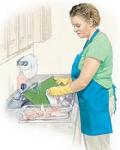 Always wash your hands before handling food and dishes and after using the toilet, gardening, changing diapers or handling pets or farm animals, particularly young animals like calves.
Always wash your hands before handling food and dishes and after using the toilet, gardening, changing diapers or handling pets or farm animals, particularly young animals like calves.- Wash fruits and vegetables with safe water, especially if you plan to eat them raw. You can also peel fruit that you will not cook.
- Never cook for other people if you have diarrhea.
- Avoid unpasteurized milk or dairy products and unpasteurized juices. Cooking kills Cryptosporidiumand other microorganisms.
- Do not swim in public pools or lakes if you have diarrhea.
- Don’t swallow any water from lakes, rivers, pools or jacuzzis. Water swallowed accidentally while swimming may contain the organism.
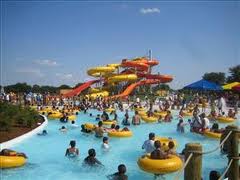
- Take care when traveling in developing countries. Foods and drinks, in particular raw fruits and vegetables, tap water or ice made from tap water, unpasteurized milk or dairy products, and items from street vendors may be contaminated with Cryptosporidium. Talk to your health care provider about other precautions you may want to take when traveling abroad.
Watershed protection
Watershed protection is another barrier to Cryptosporidium in drinking water. Mature cattle and livestock are likely a main source of contamination of a watershed. Deer, muskrats, voles, birds, and other wildlife species, in addition to sewage (human or agricultural) also impacts a watershed area. Land use controls such as septic system regulations and best management practices to control runoff can help keep human and animal wastes out of the water.
Water treatment and monitoring regulations
Under the Surface Water Treatment Rule of 1989, public water systems are required to filter surface water sources unless water quality and disinfection requirements are met and a watershed control program is maintained. This rule, however, did not address Cryptosporidium . The U.S. Environmental Protection Agency (EPA) has set standards for turbidity (cloudiness) and coliform bacteria (which indicate that pathogens are probably present) in drinking water. Frequent monitoring is required so officials will have an early warning of potential problems and can take steps to protect public health. Unfortunately, there are no water quality indicators that can reliably predict the occurrence of Cryptosporidium . More accurate and rapid assays for oocysts will make it possible to notify residents promptly if their water supply is contaminated withCryptosporidium and thus avert outbreaks.
Efforts are under way to answer questions about the occurrence, detection, and treatment of Cryptosporidium in water so that the EPA and individual states can set specific standards for this parasite in the future. The collaborative efforts of water utilities, government agencies, health care providers, and individuals are needed to prevent outbreaks of cryptosporidiosis.
How can you tell if tap water is safe?
Properly drilled and maintained wells that tap into ground water are unlikely to contain pathogens because of the natural filtration that takes place as water percolates down through the soil. But, contaminants may get into groundwater aquifers that lie beneath coarse soils or fractured bedrock. Very shallow or poorly constructed wells and springs can be contaminated with surface water runoff that carries disease-causing microbes. It is important that the well be protected from surface contamination by an intact well casing, proper seals, and a cap above ground.
The risk of waterborne cryptosporidiosis from public drinking water varies depending on the quality of the source water and type of water treatment. HIV-infected persons should follow guidelines issued by the CDC and talk with their health care providers about safe drinking water. When routine testing of public drinking water indicates potential danger, the health department or water utility will issue a “boil water” notice.
How can you make sure your own drinking water is safe?
There are three measures you may wish to take to ensure that your drinking water is safe: boil your water to kill the pathogen, remove oocysts from your water with certain types of filters, or drink certain types of bottled water.
Boiling water is the best method of killing Cryptosporidium and other waterborne pathogens; water should be brought to a rolling boil for at least one minute. It should be stored in the refrigerator in a clean bottle or pitcher with a lid. To prevent recontamination, be careful not to touch the inside of the water bottle or lid.
Water can be filtered to remove Cryptosporidium oocysts and the cysts of another protozoan parasite, Giardia lamblia . Point-of-use filters may be used to treat the water for drinking or preparing foods. They may be either attached to a faucet or have a pour-through design. Only filters with an “absolute” (not “nominal”) pore size of one micron or smaller will remove all the oocysts (viruses, however can pass through a one micron filter). The pores of reverse osmosis (RO) are too small for oocysts to pass through. NSF International, an independent, nonprofit testing agency, publishes lists of filters and RO units certified for “cyst reduction.” Follow the manufacturer’s instructions that are supplied with water treatment equipment to prevent clogging and ensure proper filtration. The filter cartridge(s) and membranes will need to be replaced periodically. Improper maintenance can actually increase health risks.
Isn’t all bottled water safe to drink?
Under current standards, bottled water is not necessarily any safer than tap water. Bottled water from deep wells (groundwater sources) has a very low likelihood of containing oocysts, but bottled water from a surface water source has the same risk of containing oocysts as tap water from that source unless it is treated before bottling.
Read the label on bottled water for information about the water source and treatment. Water can be distilled or pasteurized to kill all pathogens before bottling. Procedures for using ozone to inactivate oocysts in bottled water have not yet been established. Oocysts can be removed by reverse osmosis or a filter with an absolute one micron rating. Other microfiltration or ion-exchange methods or treatment with chlorine, carbon dioxide, or ultraviolet light cannot promise cryptosporidium-free water.
The heat of pasteurization will kill all pathogens in dairy products. Bottled and canned carbonated drinks such as sodas and beer are usually heated or filtered enough to kill or remove Cryptosporidium .
How can you avoid getting cryptosporidiosis?
You can minimize the chances of getting infected with Cryptosporidium (and numerous other pathogens) by always practicing good hygiene, especially after possible exposure to sources of infection. People with compromised immune systems must consistently take precautions to avoid exposure to Cryptosporidium.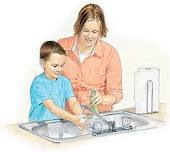
- Wash your hands thoroughly with soap and water (and supervise children’s handwashing)
- after using the toilet or changing diapers,
- after handling animals or cleaning up feces,
- after working in soil or touching any objects such as shoes that may have been contaminated with fecal matter, and
- before preparing, serving, or eating food..
- Avoid drinking untreated water from lakes, streams, and other surface water bodies.
- Because of possible contamination with manure, peel or rinse fruits or vegetables to be eaten raw.
- Take extra care in selecting food and drink when traveling to places with poor sanitation.
- Follow any water advisory issued by local health departments, state authorities, or the National Centers for Disease Control and Prevention.
- To treat contaminated water before drinking it, bring it to it a rolling boil for at least one minute to kill oocysts or remove them with a filter with an absolute pore size of one micron or smaller.
Foods such as unwashed fruits and vegetables especially from foreign countries, swimming pools, recreational water, day-care centers, and nursing homes are common sources. About one-third of the world population has been exposed to Cryptosporidium, indicating that there are many possible sources of exposure. The common factor for all Cryptosporidium exposure is contamination from stools of infected humans or animals.

